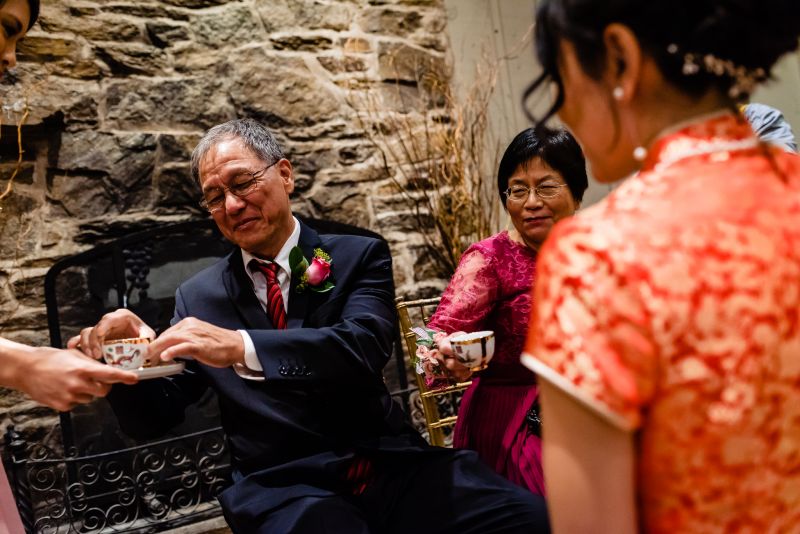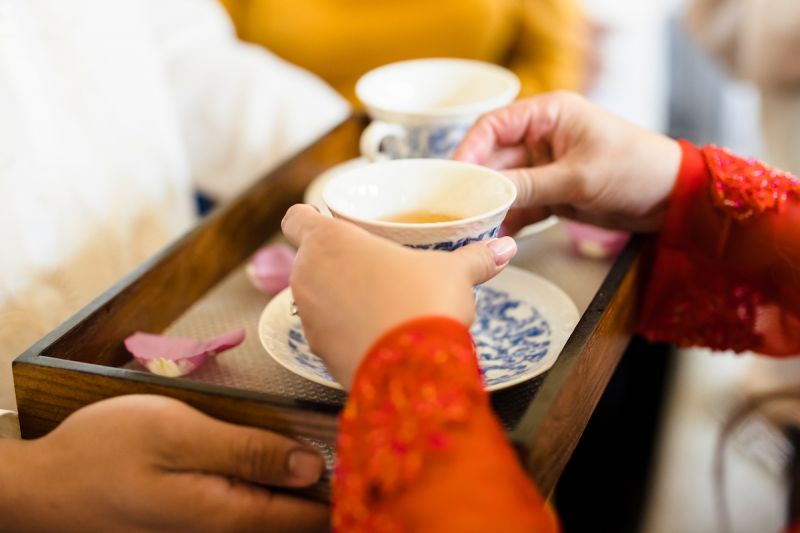
Tea ceremonies are a traditional part of many Chinese, Vietnamese and other Asian weddings. They are important rituals that symbolize the couple’s respect for their families, and their commitment to each other. The ceremony usually takes place at the bride’s house, but it can also happen in other locations, such as hotel rooms, gardens, or wedding ceremony sites. In this article, we’ll review what you need to know as the photographer or cinematographer, and give you some tips and inspiration for photographing this beautiful tradition!

Understand and Manage The Timeline
As with most cultural traditions, each couple and each family may take a unique approach to cultural traditions. For example, some Vietnamese couples will have two ceremonies, one at the bride’s house and then another one at the groom’s home. Other times, they only have one, and sometimes they skip the event all together. In another example, when a Chinese or Vietnamese bride or groom is marrying someone from another culture, it’s not uncommon to see the tea ceremony incorporated into the wedding ceremony itself rather than as a separate event.
As the creative on the job, be sure to memorize and understand the timeline and be flexible for any last second changes or requests. If there are going to be multiple tea ceremonies and outfit changes, make sure the timeline is adequate for full coverage, especially if you’re covering prep for each outfit. Travel time can also add up quickly in densely populated areas. It is not unusual for Chinese or Vietnamese wedding coverage to run between 12 and 18 hours.
Here is a typical order of events for a tea ceremony:
- Groom and his family/friends arrive at bride’s home
- Door games (more common in Chinese weddings)
- Bride makes an entrance
- Welcome Speech or toast (often by father of the bride)
- Brewing of Tea (Bridesmaid or sibling)
- Tea served by bride and groom to relatives (often in order or seniority)
- Gifts provided to the bride and groom (often jewelry)
- Food (Often a roasted pig)
Be Prepared for “Everyday” Surroundings

As mentioned, most tea ceremonies take place in the bride’s living room. Sometimes these can be beautifully decorated and photogenic and other times, they can be everyday living rooms, with potentially distracting elements like televisions, kids’ toys and more. Be prepared for any type of environment and utilize your composition and lighting skills to deemphasize unattractive parts of the scene.
Be Prepared for Tight Spaces

Many tea ceremonies have dozens or even hundreds of relatives and friends gathered in a living room or hotel suite. Be prepared for tight spaces and be sure to stay assertive, while remaining polite, in getting to the optimal positions. Consider medium zoom lenses, such as a 24-70mm lens for maximum versatility.
Plan Your Angles
If you’re shooting alone and can only get one perspective, it’s usually more important to get an angle that features the people the bride and groom are serving, as opposed to the bride and groom. For coverage with multiple shooters, capture both the bride and groom as well as the guests they’re serving.


Crop in Tight and Remember the Details
Remember to capture a variety of angles and perspectives. The most creative and interesting crops are sometimes the tight ones. This is particularly true if the environment is messy or unappealing.

In addition, tight crops of the action, such as the image of just the hands holding the tea or putting on jewelry can help tell a story. See the images below.



Focus on Emotion
In many traditional Asian cultures, the tea ceremony is the actual moment that the bride and groom are married. Traditionally, it signifies the moment that the bride is leaving her home and joining the groom in a new life. As you can expect, this can trigger some strong emotions of joy and sadness for the couple and their family members. Be prepared to capture the action.



Carve Out Time Before or After the Ceremony for Portraits
Many times, the bride and groom will be changing out of their traditional attire into a white “Western” wedding dress after the tea ceremony. So be sure to capture all of the individual and couples portraits that you and your clients want before this happens. Tea ceremonies are often followed by lunch, so you may have some time there to pull the couple out while everyone else is eating.


Conclusion
We hope that this helps prepare you to capture better tea ceremony images. If you’re interested in more wedding photography education, we have a full training system that teaches you every aspect of wedding photography, including how to capture cultural weddings such as the tea ceremony. For more information, check out the Wedding Photography Training System. If you’re interested in learning about other cultural weddings, you may be interested in the following articles:
- Jewish Wedding Photography Tips
- Persian Wedding Photography Guide
- Hindu Wedding Photography Guide
- Mormon Wedding Photography Guide
- Catholic Wedding Photography Guide





Get Connected!